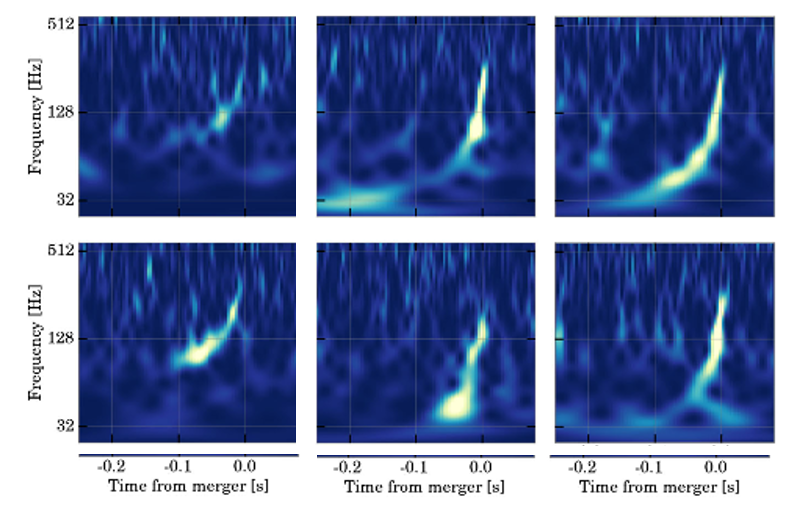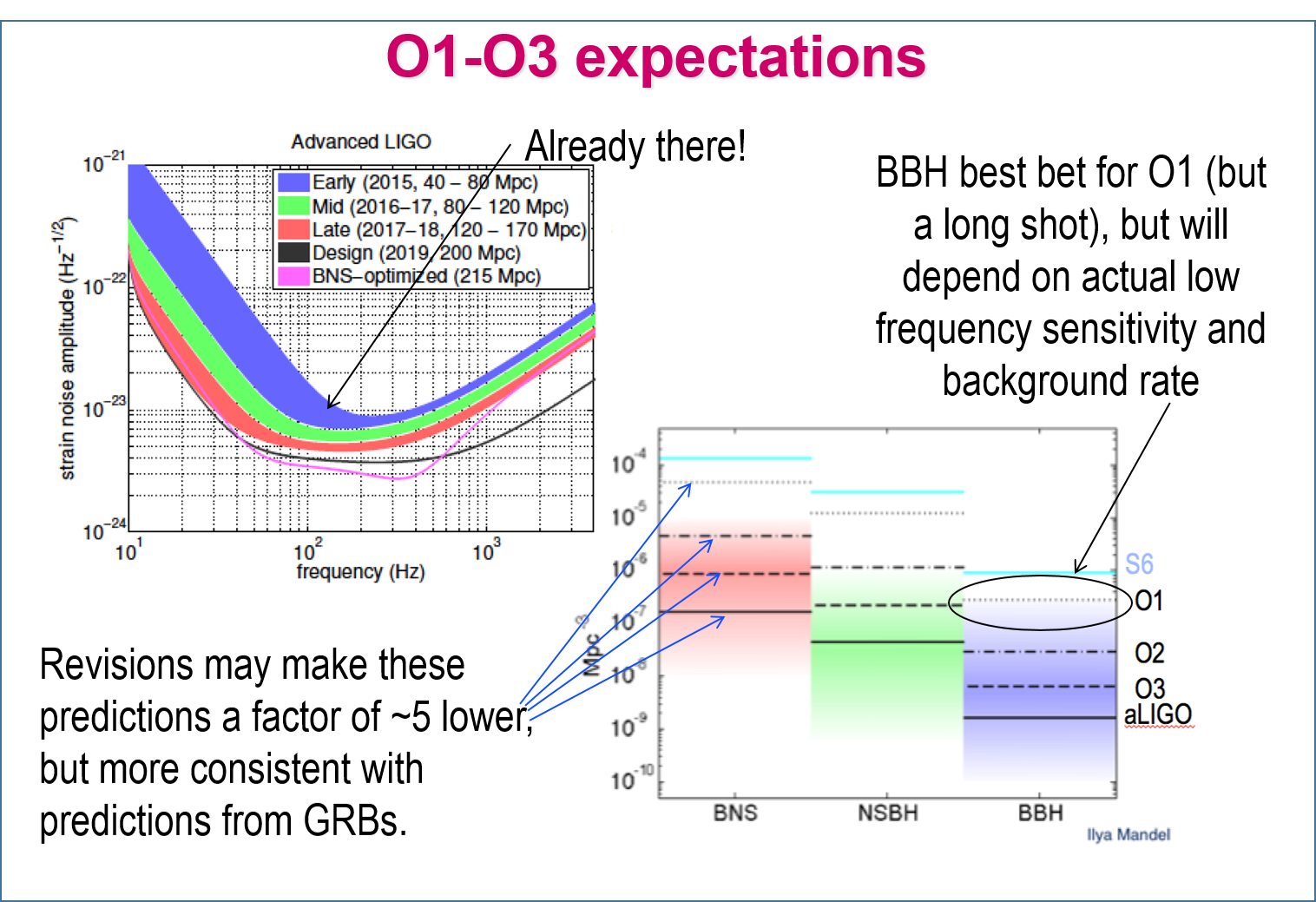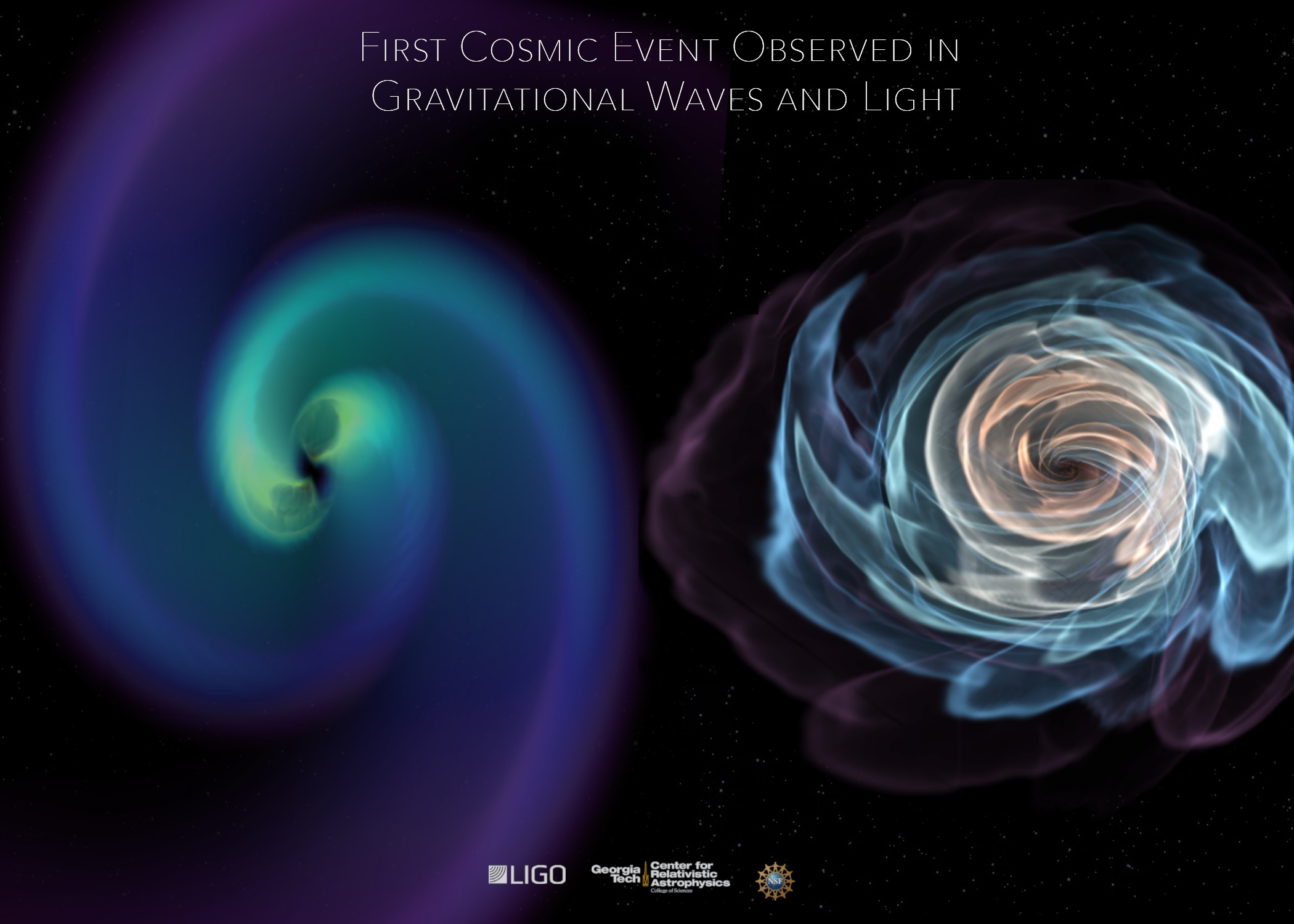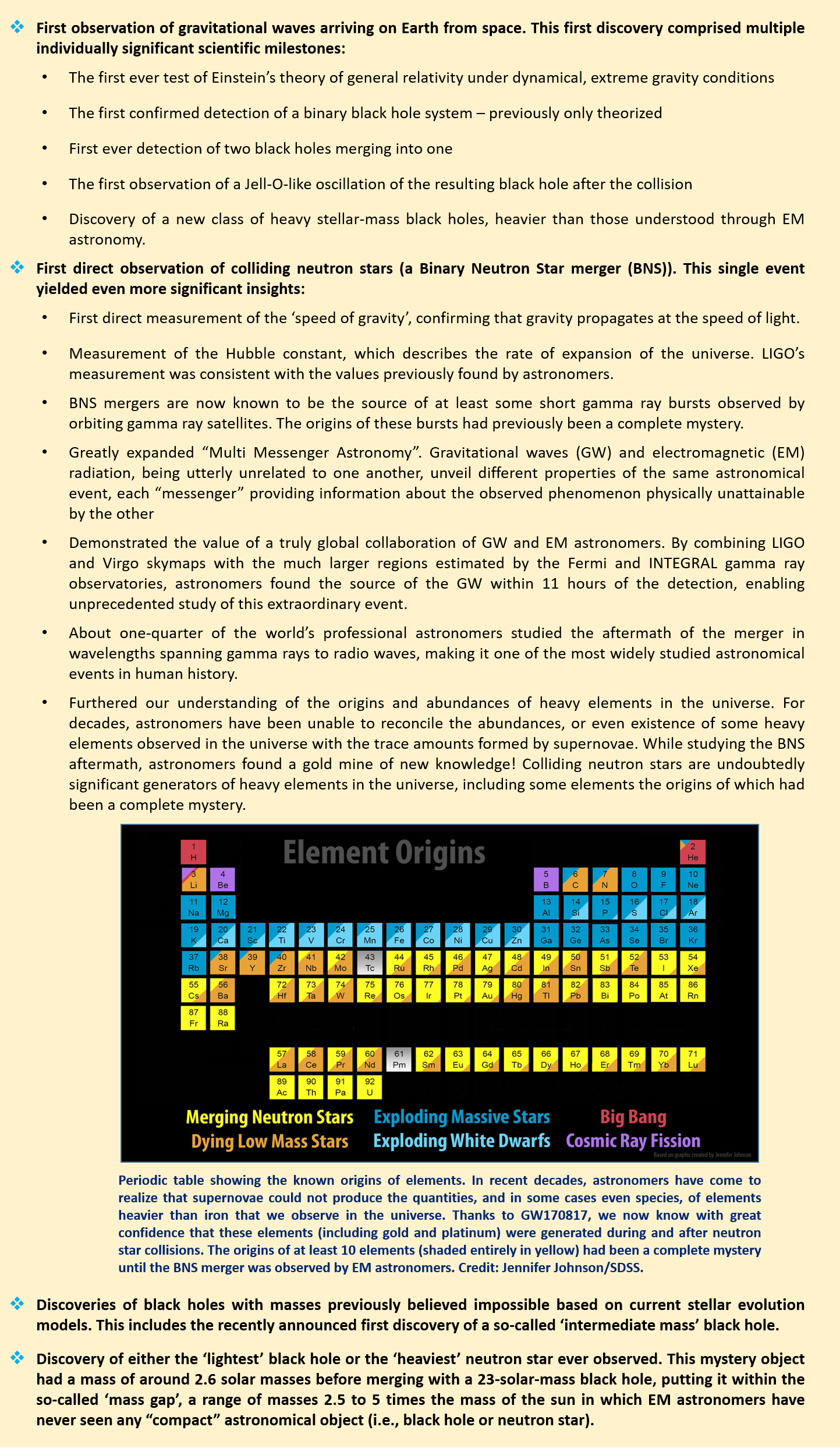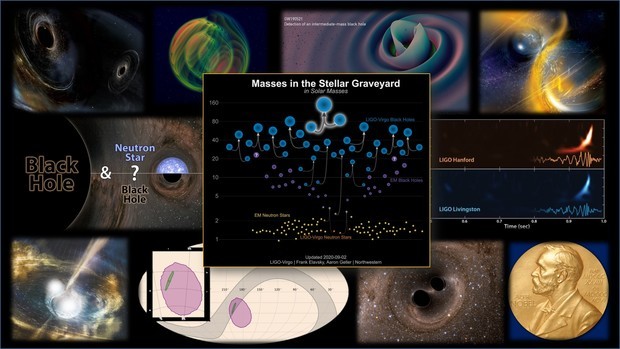
Collage of highlights of LIGO/Virgo achievements in the last 5 years. Images taken from multiple news items.
LIGO Celebrates 5th Anniversary of First Gravitational Wave Detection
News Release • September 14, 2020
By Kimberly Burtnyk, LIGO Laboratory Science Writer/Technical Editor
For those of us on the inside, it still seems like yesterday. I imagine that’s also the case for those few on the inside of the inside; those who knew hours before the rest of us, receiving phone calls and emails in the wee hours of the North-American morning of Monday, September 14, 2015. The rest of us had to wait until we had arrived at the office later that day, or even the next. At first, finding closed doors, hushed conversations, and then finally the rumor emerging from the darkness: LIGO had detected gravitational waves for the very first time.
More astonishingly, it occurred right before the official start of the first observing run (“O1”) of LIGO’s new-and-improved “Advanced” instruments. When it happened, LIGO was engaged in an engineering run leading up to the official start of O1. An engineering run is essentially a full-dress rehearsal. A few details not yet in place, but essentially, the laser interferometers at Livingston Louisiana and Hanford Washington were in perfect working order. No one even remotely expected a detection of any kind at that moment, no less a ‘textbook’ case right off the bat. It’s no wonder we took our time vetting the detection and keeping it top-secret for months: it really did look too good to be true. And yet, undeniably, there it was.
Five years after the astronomical event that shook the world, Mike Landry, LIGO Hanford Observatory (LHO) Head reflected on how stunning that first detection really was.
“What surprised me is that we didn’t start the field with a ‘threshold’ event”, he said. “We kind of expected that we’d have some sort of weak event then write an ‘evidence for’ paper that wouldn’t be definitive at all and you’d always be second guessing whether or not you’d really seen anything. Instead, we got this unbelievably loud signal that was unequivocal.”
Gabriela Gonzalez, Physics and Astronomy Professor at Louisiana State University (LSU), and LIGO Scientific Collaboration (LSC) spokesperson at the time of the detection, was also taken aback by the nature of this first-of-its-kind event.
“With the first detection, one of the things that actually made us gasp was that the two black holes were very large! Larger than X-ray astronomers had known, so that was something that made us think, ‘well we really need to be right about this because if it is right, it’s 2 discoveries.”
New Kid on the Block
At the time of the detection, I was still relatively new to LIGO, having assumed a non-scientific post at the end of May, 2014. During my job interview in February, I remember LIGO Executive Director, Dave Reitze, saying something like, ‘Well, in 5 years when we have our first detection…’. As we sat chatting in his office at Caltech, the wave was a mere 19 months away.
Given the learning curve that comes with taking any job at LIGO, in December of 2014, I took advantage of an open call to do a “Data Quality Shift”. As part of that effort, I learned what an ‘omega-scan’ was: A pretty, blue-backgrounded graph revealing sudden rapid changes in the positions of the interferometer’s main mirrors (“test-masses”) over time. During a DQ shift, I was helping to spot ‘glitches’.
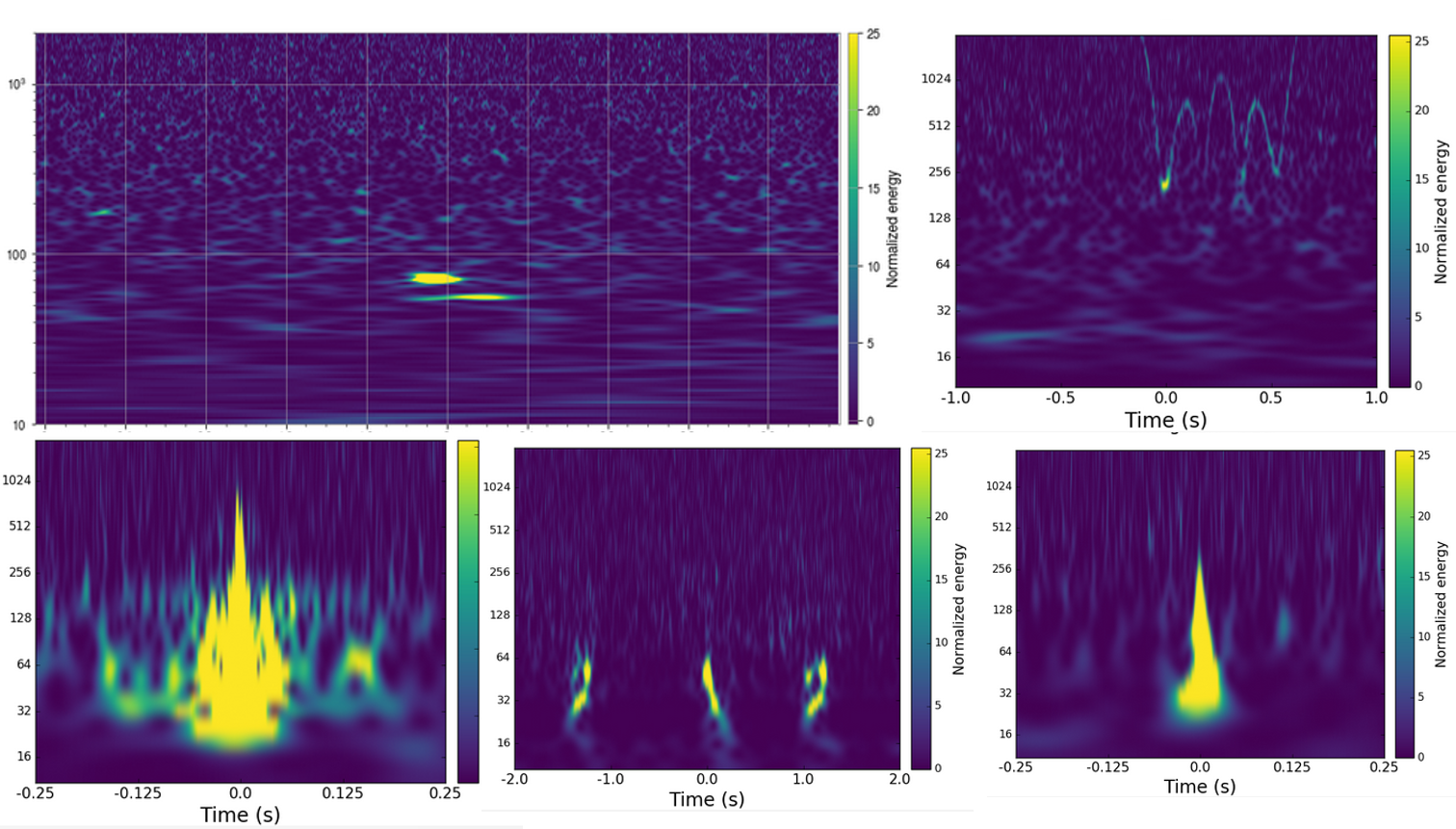
Some random glitches not caused by a gravitational wave. In these plots, time is on the horizontal axis, and frequency on the vertical, like a voiceprint.
Glitches are random bits of noise that appear in LIGO’s output signal that can obscure or even mimic a gravitational wave. Sometimes the source is known, other times, not. Spotting and understanding glitches is important to being able identify an actual gravitational wave signal when it appears. (Classifying glitches is an ongoing task and one that the public can help with through the Zooniverse program, “Gravity Spy”.)
Continuing my self-education, I poked around another site run by numerical relativists (Simulating eXtreme Spacetimes) that showed examples of what a real gravitational wave signal would look like in an omega scan. SXS also has simulated ‘chirps’, the audible equivalent of the omega-scan. They’re called chirps because the frequency (pitch) of each gravitational wave signal increases in time, starting lower and getting a little higher as the source-objects spiral into each other ever faster. How long a chirp lasts and how high its peak depends entirely on the source generating the wave. Thus, each one is unique, like a fingerprint.
And so, with the DQ shift under my belt and the knowledge acquired from SXS, on the morning of Tuesday September 16th, I opened an email that included a link to an “omicron plot”, the first visual of the mysterious signal everyone was now whispering about.
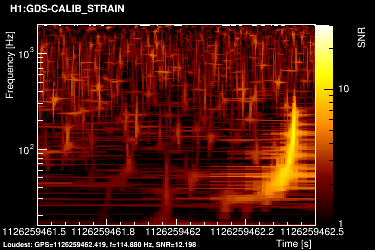
Original "omicron" plot of the first detection. This is the signal as seen in the Hanford interferometer in Washington State.
Within a day, the now-famous omega scan of the gravitational wave signal as it appeared in both the Livingston and Hanford detectors was also generated, along with its associated ‘chirp’.
Immediately, the hair on my arms stood up. From my DQ shift, I knew what a ‘real’ signal would look and sound like, and there it now was on my screen. “Oh my God!” I exclaimed out loud to no one, “it worked!” The excitement welled up inside me as I began to comprehend the magnitude of what I was seeing: LIGO had achieved its decades-long quest to detect a gravitational wave. The instruments, meticulously designed, developed, and coaxed into operation over the course of 40 years, had worked exactly as hoped.

Omega scan of GW150914 as seen at (left) LHO and (right) LLO. The signal arrived at LLO 7ms before LHO. At two-tenths of a second long, the signal lasted barely longer than the blink of an eye. LHO's signal appears brighter than LLO's because LHO's interferometer was experiencing less 'noise' at the time of the wave's arrival so it stood out more against the background.
Below you can listen to the 'chirp' of the event. The sound was made by converting the flickering light signal from the interferometers' lasers into a sound. In the first two runs, the frequencies of the sound-wave exactly match the frequencies at which the mirrors moved with the passage of the gravitational wave. The second two runs repeat the sounds but at higher frequencies making it easier to discern.
Personally, I wondered whether the dozens of LIGO engineers and scientists who had spent decades of their own careers believing in this project felt enormous relief. Surely, there must have been doubt in the backs of their minds: ‘will it work?’, ‘can it work?’, ‘will we ever detect something?’ Literally in the blink of an eye on September 14, 2015, all those questions were answered; any doubts dissolved.
Omega scans are now a familiar LIGO product, the characteristic GW signals, when visible to the eye (not all events are powerful enough to generate a signal visible to the eye in an omega scan), betraying the stealthy passage of waves of gravitational energy until now imperceptible to meagre human senses. In the last five years, LIGO has given us this new sense, and the Universe is speaking to us in new and exciting ways.
Omega-scans (aka time-frequency maps) for six binary black hole merger events. (Image adapted from https://arxiv.org/abs/1811.12907 by the LIGO Scientific Collaboration and the Virgo Collaboration).
As Luck Would Have It
Today, five years and three observing runs later, no one would have dared presume a groundbreaking discovery was just around the corner. Or would they?
Gaby Gonzalez recalled a talk she gave at the semi-annual LSC fall meeting in Budapest on September 2nd, 12 days before the detection.
“I was showing what sensitivities we had in the detectors and comparing that to predictions for mergers of neutron stars and said, ‘we’re far from that’ so we probably won’t see that, but black holes? Who knows? They were our best bet. I still have the slide showing the circle saying, ‘here, black hole mergers are our best bet, and we shouldn’t discard it’.”
Gonzalez's slide from twelve days before the first detection, showing her cautious optimism that LIGO could detect a black hole merger—if they even existed, of course. At the time, binary black holes only existed in theory.
Gonzalez added,
“We were getting prepared, and we were actually discussing the procedures for first detection, even though none of us really believed we would have a detection in O1. We sometimes informally called [O1] a test-run because we probably wouldn’t see anything, but we would learn to do analysis. But I had been pushing: We have to be ready for a detection because if it happens we can’t be unprepared.”
Today, her words seem prophetic. But they really demonstrate the confidence that LIGO scientists and engineers had in the technology. Like many who joined LIGO long before Gonzalez, she too believed the instrument would work (even as she tempered her confidence with the words, "long shot").
In another remarkable turn of events, less than 24h before the wave washed through the Earth, on Sunday, September 13th, filmmaker Les Guthman was in Louisiana on his first day of filming the aLIGO Documentary Project. Guthman had heard about the project about a year earlier and thought it could someday make for an interesting film. That week, his plan was to be onsite to record activities leading up to the start of the first observing run of the Advanced LIGO detectors. He would build the documentary over several years, eventually (optimistically) culminating in LIGO’s first detection. As luck would have it, he didn’t have to wait that long. The next day, he was in the control room at LIGO Livingston, learning about the historic discovery. Joe Giaime, LIGO Livingston Observatory Head, amusingly remembered Guthman's visit that week.
“Les Guthman was supposed to do this long-term longitudinal project. And on his first day, it was not so longitudinal anymore!”
Gonzalez fondly remembered hosting her own visitors at LLO on the 14th.
“We had visitors that day from LSU who were not clued in; they were just visitors. And it was funny. We couldn’t tell them anything and we were all hugging each other and they didn’t know why.”
Broader Impacts of the Event
Reminiscing about that day and the days and weeks that followed is still fun for many at LIGO. And much has been written and recalled about that historic first detection. But what have we learned in the intervening five years? What is LIGO now telling us about the invisible side of the Universe? And what does the future hold for this emerging field of scientific inquiry?
Changes have occurred in cultural, organizational, and of course scientific arenas. On the organizational and cultural side, said Mike Landry, “we went from being hermetically sealed in O1 [disclosing discoveries to very few] to a private network of 96 different electromagnetic and neutrino collaborators with 200 different instruments, to public alerts in O3, which is admittedly a much better place to be”. (For those with an Android or iPhone, there’s even an app for that.)
Joe Giaime also reflected on the impact of the first detection on the LIGO Scientific Collaboration.
“The wonderful thing about the discovery was that most of the collaboration, the people involved in data analysis and the connection to astrophysics, before [the first detection], they didn’t have much of a role in our thinking about things. Now it’s a big booming collaboration where it’s clear to all of us that we couldn’t do it all without all those different factions of different interests and talents.”
Giaime added, “It’s amazing we all found each other in advance of the science and put up with each other all those years when nothing was being discovered so that we had all that talent on the team when we needed it.”
The collaboration itself is growing. With Virgo now regularly joining LIGO in searches (Virgo had its first detection in 2017 and was instrumental in localizing the source of the BNS merger and gamma-ray burst that year), and our Japanese colleagues at KAGRA, which made a fleeting appearance at the very end of O3, what was once just the LIGO Scientific Collaboration is now the LIGO-Virgo-KAGRA (LVK) collaboration. Another giant leap forward in gravitational wave astronomy.
Impacts have been felt more broadly, too. Keita Kawabe, LIGO Senior Scientist and Detection Lead at LHO, reflected on the impact of the discovery on the entire scientific community.
“One thing that was really striking to me after the first detection is how the response of the outside world changed. Not the newspapers, but the physicists and astronomers. Before [the detection] they were wondering, ‘can you really do it?’ or [in some cases] asserting that it could not be done. Now years [later], no one has any serious doubts about the claims of detections.”
Kawabe believes the biggest turning point came with the binary neutron star (BNS) merger in August 2017, which was observed by gravitational-wave and electromagnetic astronomers alike, rapidly inflating the field of multi-messenger astronomy.
This visualization shows the coalescence of two orbiting neutron stars. The right panel contains a visualization of the matter of the neutron stars. The left panel shows how space-time is distorted near the collisions. Credit: Karan Jani, Georgia Tech.
"When we are just detecting black holes, not many people are able to do the science related to that if they don’t have access to the detectors. But then the BNS paper came out and it was clear that other people can now do the science”, said Kawabe.
Cultural changes have occurred outside of the scientific community as well. Camilla Compton, LHO operator (and former LIGO SURF student) was an undergraduate physics student when the first detection was announced on February 11, 2016. She sees the impact of the discovery from a different perspective.
“Lots of physics undergrads, six years ago, didn’t know what LIGO was”, said Compton. “At university, my lab partner and I watched the announcement, and after that, even my mum was like, ‘oh wasn’t that the thing on the news with Einstein? It was kinda cool to go from people that say they love physics or are studying physics having no idea that LIGO exists, to my mum and all her coffee friends being, ‘oh yeah!’”
At the sites themselves, LIGO Hanford Observatory went from pre-announcement public visitor numbers of around 4000 per year to over 9000, many showing up during regular business hours just to see where it all happened. LLO went from around 8500 onsite visitors to 12,000 that year, and their Science Saturday events went from hosting an average of around 200 to peaking at 1300 the weekend of the announcement, with eager visitors standing in long lines for a tour of the site.
Some enjoyed even deeper personal impacts. Giaime explained one such impact.
“Those of us outside the analysis and physics groups were able to spend time thinking about the physics involved and the analysis. I didn’t have a course I had to teach on it, so there was no need for me to learn it. But it was fun and it gave me time and a reason to spend time being a student again for a while. Hopefully we never stop now.”
Looking to the Future
Today, while the COVID-19 pandemic holds much of the world hostage, some LIGO staff are back at work preparing for a major upgrade that will once again significantly enhance LIGO’s sensitivity--most prominently, the A+ project. A+ requires the construction of a new 300m stretch of vacuum beamtube adjacent to the existing arms of LLO’s and LHO’s interferometers. That construction will take nearly 2 years to complete but the upgrade is expected to bring LIGO’s interferometers to their ‘design sensitivities’ and beyond.
Longer term, LIGO in the United States will grow to include the LIGO India Observatory, making LIGO a 3-instrument network. Continuing our collaboration wtih our international partners, Virgo and KAGRA, soon the gravitational-wave astronomy community will comprise a worldwide network of five comparable-sized detectors operating 24/7.
Considering what will be a 1.5-year wait for LIGO and Virgo to start their next run, Gaby Gonzalez looks optimistically to the near and more distant future of gravitational wave science. “This is just the beginning. It’s not just ground-based observatories. A pulsar-timing discovery should be possible in the next few years. LISA of course will take a bit longer to fly, but it is making great progress and everyone is excited about it”, she said.
LISA, the Laser Interferometer Space Antenna, is a space-based gravitational wave observatory being co-developed by the European Space Agency and NASA. It is currently planned for launch sometime in the mid-2030’s.
Giaime also looks forward to some new discoveries, saying, “the only thing we haven’t seen that we’d like is something that was truly unexpected or unknown that represented a new kind of source that people hadn’t thought of before. But we have to leave something for the future”.
These past five years have been a whirlwind. Fifteen mergers have been published in scientific journals, while dozens more await further scrutiny. In the last 10 weeks alone, LIGO has shared two more amazing discoveries: the largest stellar-mass black holes ever observed, and a mysterious object residing in the so-called 'mass gap'. In the years and decades to come, LIGO, Virgo, and KAGRA will continue to expand their global collaboration with optical, radio, neutrino, and gamma-ray astronomers, so there is no telling what wonders await us. What we can say with certainty is that the future looks bright for studying the dark side of the Universe.

